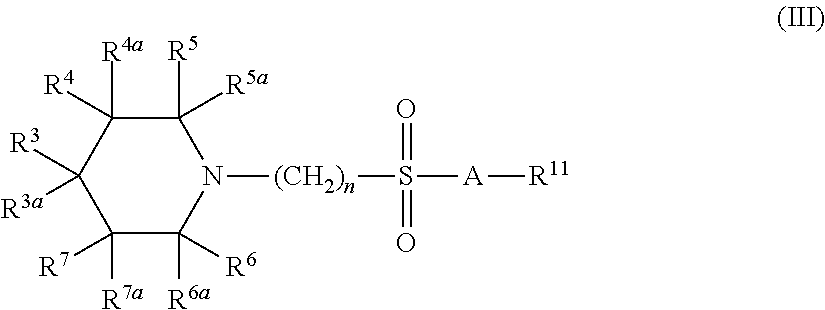Methods and compositions for treating amyloid-related diseases
a technology for amyloid-related diseases and compositions, applied in drug compositions, extracellular fluid disorders, metabolic disorders, etc., can solve the problems of amyloid fibrils, once deposited, becoming toxic to surrounding cells, progressive memory loss, severe pain, etc., to block amyloid-induced neurotoxicity or microglial activation, slow down deposition, and block amyloid-induced cellular toxicity or macrophage activation
- Summary
- Abstract
- Description
- Claims
- Application Information
AI Technical Summary
Benefits of technology
Problems solved by technology
Method used
Image
Examples
example 1
Synthesis of Representative Compounds of the Invention
[0599]The present invention also relates to novel compounds and the synthesis thereof. Accordingly, the following examples are presented to illustrate how some of those compounds may be prepared.
[0600]The synthetic protocols of compounds C; D; E; F; G; H; I; J; K; L; M; N; P; Q; R; S; X; Y; Z; AA; AB; AC; AD; AE; AF; AG; AH; AJ; AK; AL; AM; AV; AW; AY; AZ; BA; BB; BW; BY; BZ; CE; CG; CH; CI; CJ; CK; CL; CO; CV; DD; DG; DH; DI; DJ; DK; DL; DM; DO; DP; DQ; DR; DS; DT; DU; DV; DW; DX; DY; DZ; EA; EB; EC; ED; EE; EF; EG; EH; EI; EJ; EK; EN; EO; EP; EQ; ER; ES; ET; EV; EW; FN; FO are described at pages 155 to 201 of co-owned PCT publication No. WO 2004 / 113275, which is incorporated herein in its entirety.
Preparation of 3-{[(1S)-1-benzyl-2-(benzyloxy)-2-oxoethyl]amino}propane-1-sulfonic acid (Compound EL)
[0601]L-Phenylalanine benzylester hydrochloride (2.0 g, 6.9 mmol) was treated with a saturated aqueous solution of K2CO3 (50 mL) and ...
example 2
Binding and Antifibrillogenic Assays
[1098]A representative number of compounds according to the invention were synthesized and screened by mass spectrometry (“MS”) assays, except for selected compounds which were purchased from a commercial source. The MS assay gives data on the ability of selected compounds to bind to proteins, in this example, to Aβ40.
[1099]Samples were prepared as aqueous solutions (adding 20% ethanol if necessary to solubilize in water). For those compounds selected from Table 2A, the binding experiment was done with 200 μM of a test compound and 20 μM of solubilized Aβ40, or 400 μM of a test compound and 40 μM of solubilized Aβ40. For those compounds selected from Table 3A and Table 3B, the binding experiment was done with 150 μM of a test compound and 30 μM of solubilized Aβ40. The pH value of each sample was adjusted to 7.4 (±0.2) by addition of 0.1% aqueous sodium hydroxide. The solutions were then analyzed by electrospray ionization mass spectrometry using ...
example 3
Effects of Short Term Treatment in Adult Transgenic CRND8 Mice Overexpressing βAPP
[1102]Transgenic mice, TgCRND8, expressing the human amyloid precursor protein (hAPP) develop a pathology resembling Alzheimer's disease. In particular, high levels of Aβ40 and Aβ42 have been documented in the plasma and the brain of these animals at 8-9 weeks of age, followed by early accumulation of amyloid plaques similar to the senile plaques observed in AD patients. These animals also display progressive cognitive deficits that parallel the appearance of degenerative changes. See, e.g., (Chishti, et al., J. Biol. Chem. 276, 21562-70 (2001).
[1103]The short term therapeutic effect of 19 compounds of the invention was studied. These compounds were administered over a 14 or 28 day period at the end of which the levels of Aβ peptides in the plasma and brain of TgCRND8 animals were determined.
Methods
[1104]Male and female transgenic mice from the 3rd and 4th B6C3F1 generations were used in this example a...
PUM
| Property | Measurement | Unit |
|---|---|---|
| Rh | aaaaa | aaaaa |
| Ri | aaaaa | aaaaa |
| pharmaceutical composition | aaaaa | aaaaa |
Abstract
Description
Claims
Application Information
 Login to View More
Login to View More - R&D
- Intellectual Property
- Life Sciences
- Materials
- Tech Scout
- Unparalleled Data Quality
- Higher Quality Content
- 60% Fewer Hallucinations
Browse by: Latest US Patents, China's latest patents, Technical Efficacy Thesaurus, Application Domain, Technology Topic, Popular Technical Reports.
© 2025 PatSnap. All rights reserved.Legal|Privacy policy|Modern Slavery Act Transparency Statement|Sitemap|About US| Contact US: help@patsnap.com



